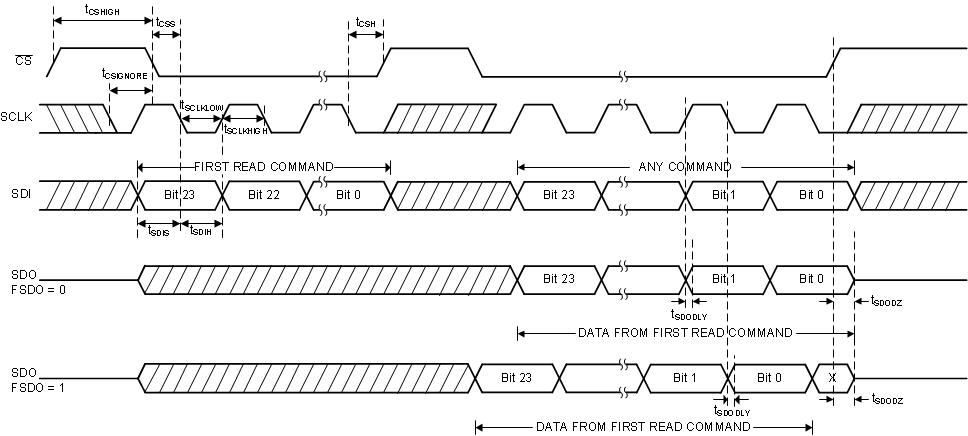SBAS871C August 2017 – January 2019 DAC60504 , DAC70504 , DAC80504
PRODUCTION DATA.
- 1 Features
- 2 Applications
- 3 Description
- 4 Revision History
- 5 Device Comparison Table
- 6 Pin Configuration and Functions
- 7 Specifications
-
8 Detailed Description
- 8.1 Overview
- 8.2 Functional Block Diagram
- 8.3 Feature Description
- 8.4 Device Functional Modes
- 8.5 Programming
- 8.6
Register Map
- 8.6.1 NOP Register (address = 0x00) [reset = 0x0000]
- 8.6.2 DEVICE ID Register (address = 0x01) [reset = 0x---]
- 8.6.3 SYNC Register (address = 0x2) [reset = 0xFF00]
- 8.6.4 CONFIG Register (address = 0x3) [reset = 0x0000]
- 8.6.5 GAIN Register (address = 0x04) [reset = 0x---]
- 8.6.6 TRIGGER Register (address = 0x05) [reset = 0x0000]
- 8.6.7 BRDCAST Register (address = 0x6) [reset = 0x0000]
- 8.6.8 STATUS Register (address = 0x7) [reset = 0x0000]
- 8.6.9 DACx Register (address = 0x8 to 0xF) [reset = 0x0000 or 0x8000]
- 9 Application and Implementation
- 10Power Supply Recommendations
- 11Layout
- 12Device and Documentation Support
- 13Mechanical, Packaging, and Orderable Information
Package Options
Mechanical Data (Package|Pins)
- RTE|16
Thermal pad, mechanical data (Package|Pins)
- RTE|16
Orderable Information
8.5 Programming
The DACx0504 is controlled through a flexible four-wire serial interface that is compatible with SPI type interfaces used on many microcontrollers and DSP controllers. The interface provides read and write access to all DACx0504 registers and can also be configured to daisy-chain multiple devices for write operations. The DACx0504 incorporates an optional error checking mode to validate SPI data communication integrity in noisy environments. Table 7 shows the SPI timing requirements. Figure 62 and Figure 63 show the SPI write and read timing diagrams, respectively. Figure 64 shows the digital logic timing diagram.
Table 7. Programming Timing Requirements(1)
(1) All input signals are specified at tR = tF = 1 ns/V (10% to 90% of VIO), timed from a voltage level of (VIL + VIH) / 2, VDD = 2.7 V to 5.5 V, VIO = 1.7 V to 5.5 V, VREFIN = 1.25 V to 5.5 V, SDO loaded with 20 pF, and TA = –40°C to +125°C (unless otherwise noted)
 Figure 62. Serial Interface Write Timing Diagram
Figure 62. Serial Interface Write Timing Diagram  Figure 63. Serial Interface Read Timing Diagram
Figure 63. Serial Interface Read Timing Diagram  Figure 64. Digital Logic Timing Diagram
Figure 64. Digital Logic Timing Diagram